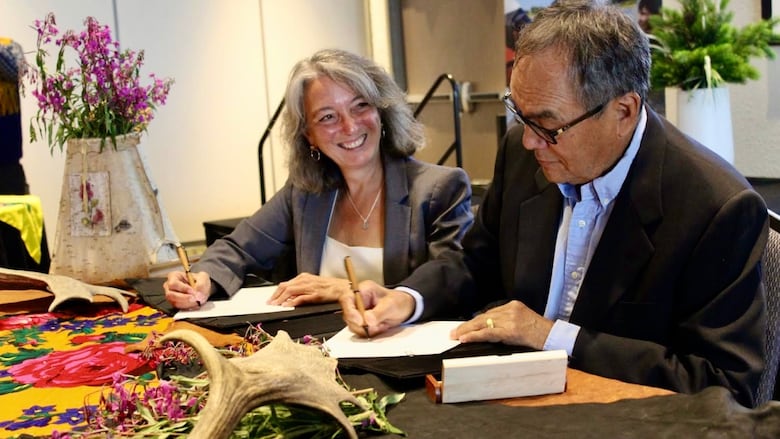Federal contribution to $375M conservation deal formalized in Yellowknife
Chair of trust hopes money starts flowing to communities this fall

Canada's environment minister signed an agreement Monday for the federal government's financial contribution to a "transformative" Indigenous-led conservation deal in the N.W.T.
More than 20 Indigenous governments in the territory, along with the federal and territorial governments, signed a $375 million deal last fall called Our Land For the Future, which uses a project finance for permanence model that combines government and private dollars for long-term conservation on a large scale.
The deal took another step forward Monday when Julie Dabrusin, the federal minister of environment and climate change, put her signature on an agreement that will transfer $300 million to the trust that's managing the money.
Another $75 million is expected to come from private donors.
"This isn't just a conservation announcement, it's really a global milestone," said Dabrusin. "This is about putting Indigenous leaders at the centre of decision making when we're talking about this land conservation."
The agreement's primary purpose is to support Indigenous-led initiatives to conserve and steward land and water in the N.W.T. That is – to identify and establish more protected and conserved areas.
It says Indigenous partners intend to protect nearly 233,000 square kilometres of land and water in the N.W.T. through new protected and conserved areas. That's a little more than 17 per cent of the territory, and a little more than two per cent of Canada.
The secondary focus of the agreement is conservation-related activities that aren't tied to protected and conserved areas. Rather than being measured in hectares, the agreement says, they can be measured by things like increases to food security, cultural revitalization, knowledge and community wellness.

Danny Yakeleya has been appointed chair of the Our Land for the Future Trust, which will manage the money. He said the agreement is "transformative" and will mean a lot for N.W.T. communities, like his own home of Tulita.
"We're looking at two protected areas. One is the Willow Lake area, it's a biosphere, very sensitive for ducks," he said. "The other is in the mountains."
Danny Gaudet, the Ɂek'wahtı̨dǝ́ (chief) of Deline, said for 21 Indigenous governments to work together is "unprecedented." He also said the deal will give communities the resources to document on paper what they've been saying is out on the land.
"So that we could prove to the people that, guess what? The world is drying up, the plant is changing, we need to adjust to what's happening," he said.
"There's a disconnect between Indigenous people that actually know everything about the land and water resources … and the legislators that are actually making decisions. There's a huge disconnect. This is an opportunity to actually start connecting it."
Yakeleya said there's still a lot of work to do before funding starts flowing to communities, such as finding an office space, hiring staff, and nailing down a distribution policy for the money. He hopes the funding can start being dispersed in the fall.
Yakeleya said he was one of the negotiators who brought the Sahtu Land Claim Agreement to fruition in the '90s. Back then, he said, he would not have been able to wrap his head around an agreement like Our Land for the Future.
"This is huge," he said. "I'm super happy about it."

